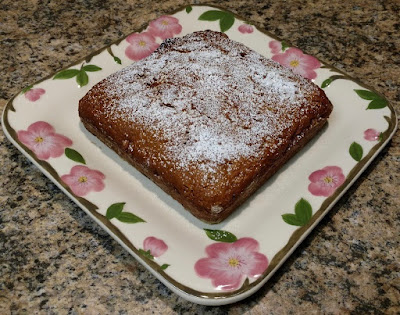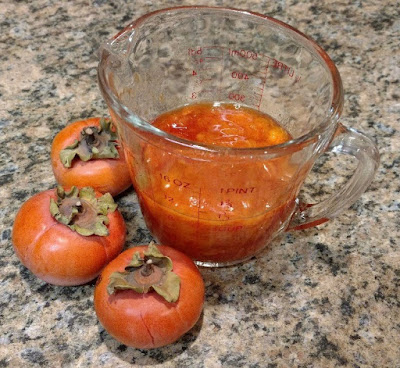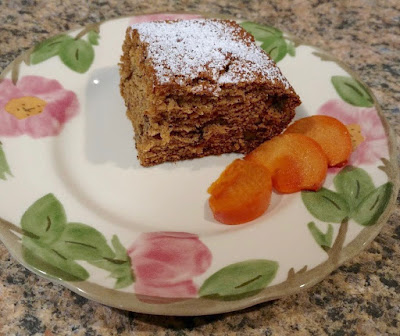
Recipe: Spicy persimmon brunch cake tastes, smells delicious

|
Persimmon season always makes me think of Jean Brine, Sacramento’s Persimmon Lady.
Back in 2010, this retired state worker wrote the definitive persimmon recipe book to answer any query about what to do with too many persimmons. Titled “Perfectly Persimmon,” her spiral-bound cookbook contains 1,010 recipes for persimmons.
The 440-page book features persimmon ideas for both Fuyu and Hachiya varieties, and everything from appetizers and salads to desserts and sauces.
“When you speak of persimmons, the only thing that comes to 90 percent of people is, 'Oh, I love persimmon cookies!’ ” Brine said in an interview after her book was released. “But that's just a drop in the bucket of what you can do with persimmons.”
Looking for something different to do with my Fuyus, I turn to her cookbook often during persimmon season. My persimmons are now at the super-ripe and mushy stage, perfect for baking.
This breakfast cake is hardy enough for a frosty morning and smells wonderful baking in the oven.
Brine’s cookbook is still available on Amazon. If you have a plentiful supply of persimmons, it’s an excellent addition to your kitchen library.
 |
|
Fuyu persimmons can be eaten ripe or crisp.
|
Spicy Persimmon Brunch Cake
Makes 9 servings
Ingredients:
1-1/4 cups pureed persimmons
1 teaspoon baking soda
½ cup (1 stick) butter or margarine, softened
1 cup sugar
2 cups all-purpose flour
2 teaspoons baking powder
¼ teaspoon salt
1 teaspoon cinnamon
½ teaspoon ground nutmeg
½ teaspoon ground cloves
1 teaspoon grated orange rind
½ teaspoon grated lemon rind
½ cup chopped walnuts
Powdered sugar
 |
| This cake is a lovely choice for brunch or dessert. |
Instructions:
Preheat oven to 350 degrees F.
Grease and flour an 8-inch baking pan.
In a small bowl or measuring cup, stir together persimmon pulp and baking soda. Set aside.
In a large bowl, cream together butter or margarine and sugar until fluffy. Add persimmon mixture; stir well.
In another bowl, sift together flour, baking powder, salt and spices. Gradually blend flour mixture into the persimmon/butter mixture. Stir in orange and lemon rinds and chopped nuts.
Spoon batter into baking pan and smooth into an even layer.
Bake at 350 degrees for 40 to 45 minutes or until a toothpick inserted near the center comes out clean.
Let cool at least 10 minutes before removing from pan. Sprinkle with powdered sugar.
Serve warm.
Adapted from “Perfectly Persimmon” by Jean Brine (Morris Press Cookbooks, 2010).
Comments
0 comments have been posted.Sacramento Digs Gardening to your inbox.
Food in My Back Yard Series
May 6: Maintain soil moisture with mulch for garden success
April 29: What's (already) wrong with my tomato plants?
April 22: Should you stock up on fertilizer? (Yes!)
April 15: Grow culinary herbs in containers
April 8: When to plant summer vegetables
April 1: Don't be fooled by these garden myths
March 25: Fertilizer tips: How to 'feed' your vegetables for healthy growth
March 18: Time to give vegetable seedlings some more space
March 11: Ways to win the fight against weeds
March 4: Potatoes from the garden
Feb. 25: Plant a fruit tree now -- for later
Feb. 18: How to squeeze more food into less space
Feb. 11: When to plant? Consider staggering your transplants
Feb. 4: Starting in seed starting
Sites We Like
Garden Checklist for week of May 11
Make the most of the lower temperatures early in the week. We’ll be back in the 80s by Thursday.
* Plant, plant, plant! It’s prime planting season in the Sacramento area. Time to set out those tomato transplants along with peppers and eggplants. Pinch off any flowers on new transplants to make them concentrate on establishing roots instead of setting premature fruit.
* Direct-seed melons, cucumbers, summer squash, corn, radishes, pumpkins and annual herbs such as basil.
* Harvest cabbage, lettuce, peas and green onions.
* In the flower garden, direct-seed sunflowers, cosmos, salvia, zinnias, marigolds, celosia and asters. (You also can transplant seedlings for many of the same flowers.)
* Plant dahlia tubers.
* Transplant petunias, marigolds and perennial flowers such as astilbe, columbine, coneflowers, coreopsis, dahlias, rudbeckia and verbena.
* Keep an eye out for slugs, snails, earwigs and aphids that want to dine on tender new growth.
* Feed summer bloomers with a balanced fertilizer.
* For continued bloom, cut off spent flowers on roses as well as other flowering plants.
* Add mulch to the garden to maintain moisture. Mulch also cuts down on weeds. But don’t let it mound around the stems or trunks of trees or shrubs. Leave about a 6-inch-to-1-foot circle to avoid crown rot or other problems.
* Remember to weed! Pull those nasties before they set seed.
* Water early in the day and keep seedlings evenly moist.